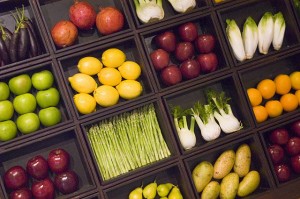But, wait a minute here. It's not until we're halfway through the article that we get to some actual numbers. The Times says participation at the start of the year dropped 13 percent.
Hmmm, down 13 percent, a "flop"? L.A. Unified Food Services Director admits the debut of the program was a "disaster," and the District has since resolved some bureaucratic problems.
Then the Times gets to the far less sexy headline: "In the last month or so, the overall program has begun to recover; participation is down by about 5% or 6%, Barrett said."
So, today, 94 percent of formerly participating children have stayed with the program. Before the District swapped out the menu, it held taste tests at its centralized kitchens and comments were overwhelmingly positive. Today, many of the new menu items such as vegetable tamales and salads are popular. The question, it seems, is real-world, on-site implementation. There's a difference between a taste test in a controlled environment and actually serving the meals day in and day out at multiple campuses. Students reported undercooked meat, soggy noodles and hard rice.
Bonnie Christensen is the Executive Chef of the lauded Berkeley Unified School District lunch initiative. Berkeley overhauled its menu six years ago and has received national awards for its accomplishments. But the early days were a challenge. Each school site is different, with different staff and different equipment. Staff training is key.
"The problem with food is there's always a variable. The broccoli doesn't grow the same way if there's a frost," Christensen told me. "In foods, the problems translate immediately. If you didn't have enough people at work that day, you have to take shortcuts to get the work done. Processed food gives you consistency, fresh made from scratch is less consistent. The way to make it consistent is training staff and having better equipment."
Bettina Elias Siegel blogs about school food reform on "The Lunch Tray" and wrote a post about the Times article. She, too, picked up on the quality control problems L.A. Unified is having and that "over- or undercooked food is of course going to be rejected by school kids, as it would be by anyone."
L.A. Unified has pledged to tinker with its menu. But Siegel asks a provocative question in her post: what if the five to six percent of children who have abandoned the program never come back and continue to make junk food their primary diet?
I know this might sound terribly callous, but I’m not sure I care. Because the hard truth is this: if we really intend to wean an entire generation of children off school food “carnival fare” (nachos, nuggets, burgers and fries) and introduce them to fresher, healthier entrees, we are, without question, going to lose some kids along the way. In other words, it’s just not that surprising if a middle- or high schooler who’s seen nothing but “better-for-you junk food”on his tray since kindergarten can’t make the leap to black bean burgers and salad, especially if there’s no context for healthier foods in his life outside of school.
But a kindergartener who’s never seen anything but black bean burgers and salads in the cafeteria is going to be a much easier sell on healthier foods throughout his school years. And that young child is our only hope if we’re going to reverse current trends in obesity and poor lifestyle habits among our nation’s children.
